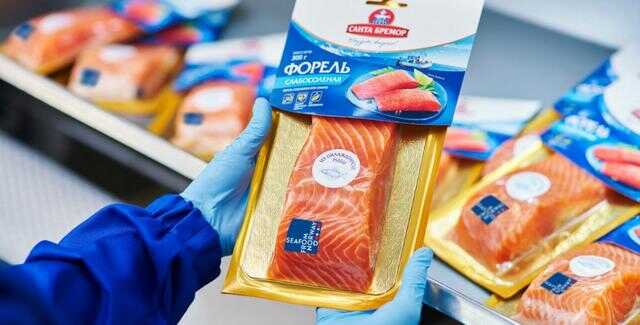Santa Bremor, a Belarusian producer, has stopped delivering salmon to Russia under the Russian Sea brand. The company can no longer get salmon farmed in Norway.
Over time, it might start using Chilean or Russian redfish instead, experts say.
A major supplier of fish products to Russia, including under the Russian Sea brand, the Belarusian company Santa Bremor has paused the supply of part of its products to retail chains. Salmon and trout “Russian Sea” have disappeared from sale on online stores, according to “Kommersant”. A source at one of the networks reported that Santa Bremor's division informed about the suspension of deliveries due to restrictions on exports from countries where salmon is farmed. writes “Kommersant”.
Lenta reported that manufacturers of red fish products have notified about possible difficulties with shipments due to a lack of raw materials. The representative of the retailer mentioned that Lenta is currently not receiving goods from the Russian Sea brand, but the situation may change in June. Another large network confirmed that the Russian Sea had a reduced assortment, attributing it to a significant price increase which made the company’s products less appealing to customers.
“Santa Bremor” is part of the Belarusian GC “Santa” managed by Alexander Moshensky. The group also includes Savushkin Produkt, a dairy products manufacturer, and the Santa supermarket chain. They are involved in real estate, restaurant and hotel projects, among others. Santa claims its turnover exceeds $2 billion.
Chairman of the Fish Union Alexander Panin mentioned that Belarusian producers of red fish products were using salmon from Norway until recently. However, import into Russia was banned by the 2014 food embargo. After a new wave of sanctions, these supplies, as well as those of the Faroese salmon, were closed. The Russian competitors of “Santa Bremor” are now relying on raw materials from warehouse stocks, according to the newspaper's sources.
Ilya Bereznyuk, Managing Partner of Agro&Food Communications, pointed out that since 2014 domestic fish processors have adapted to working with thawed salmon from Chile. They also use wild red fish from the Far East, salmon from farms in Murmansk and trout from Karelia as raw materials. Bereznyuk warned that Russian processors will face a decrease in the supply of imported raw materials due to the withdrawal of the largest container lines from Russia and challenges with payments for new deliveries.
Bereznyuk suggested that over time, Santa Bremor may replace Norwegian salmon, possibly with Russian salmon. However, this could significantly increase costs and negatively impact the company’s sales and market share, he warned. Panin noted that prices for Chilean salmon are at their peak, and problems with logistics through Europe do not encourage buying it.
According to the reports of the Chilean red fish producer Salmones Camanchaca, the average world prices for Atlantic salmon in the first quarter of 2022 increased by 34% year-on-year, to $6.77 per 1 kg. “Importers’ stocks are already running low. In the near future, we will make do with Russian farmed salmon and a small amount of imports,” Panin expects.
Ilya Sosnov, General Director of Russian Aquaculture, said that the company continues to supply fish, but in May-September there is traditionally low demand for it, so sales are small. He did not notice a decrease in demand – the results are generally in line with the business plan. “Russian Aquaculture” in the report for 2020 estimated the volume of the Russian red fish market at 114,000 tons, of which 99,000 tons are imported salmon.




